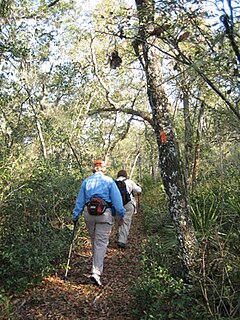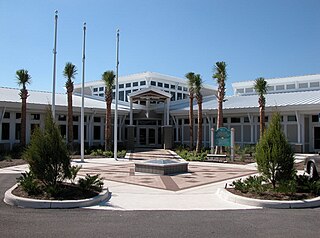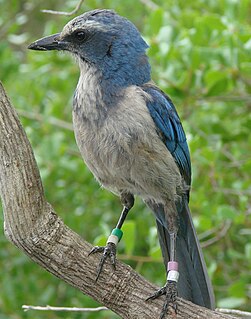
Ormond-by-the-Sea is a census-designated place and an unincorporated town in Volusia County, Florida, United States. The population was 8,430 as of the 2000 census.

Flatwoods, pineywoods, pine savannas and longleaf pine-wiregrass ecosystem are terms that refer to an ecological community in the Southeastern coastal plain of North America. Flatwoods are an ecosystem maintained by wildfire or prescribed fire and are dominated by longleaf pine, and slash pine in the tree canopy and saw palmetto, gallberry and other flammable evergreen shrubs in the understory, along with a high diversity of herb species. It was once one of the dominant ecosystem types of southeastern North America. Although grasses and pines are characteristic of this system, the precise composition changes from west to east, that is, from Texas to Florida. In Louisiana, savannas even differ between the east and west side of the Mississippi River. The key factor maintaining this habitat type is recurring fire. Without fire, the habitat is rapidly invaded by other species of woody plants.

Myakka River State Park is a Florida State Park, that is located nine miles (14 km) east of Interstate 75 in Sarasota County and a portion of southeastern Manatee County. The state park consists of 37,000 acres (150 km2), making it one of the state's largest parks. It is also one of the oldest parks in the state. It was delineated in the 1930s by the Civilian Conservation Corps. A small portion of the park was the gift of the family of Bertha Palmer to the state. The park is named after the Myakka River.

First acquired in 1977, Big Lagoon State Park is a 705-acre (2.85 km2) Florida State Park located on the northwestern Florida coast, approximately 10 miles (16 km) southwest of Pensacola on Gulf Beach Highway. It encompasses the northern boundary of Big Lagoon as it snakes toward Pensacola Bay to the east. Wild Grande Lagoon and its minor tributaries lay within the boundaries of the park, as does the alligator-inhabited Long Pond, a man-made freshwater pond.

Econfina River State Park is a 3,377 acres (14 km²) Florida State Park, located on the Gulf of Mexico at the mouth of the Econfina River. The address is 4384 Econfina River Road, Lamont, Florida, United States.

The Arthur R. Marshall Loxahatchee National Wildlife Refuge is a 147,392-acre (596.47 km2) wildlife sanctuary is located west of Boynton Beach, in Palm Beach County, Florida. It includes the most northern remnant of the historic Everglades wetland ecosystem.

The Arboretum of the University of Central Florida is located on the main campus of the University of Central Florida in Orlando, Florida, United States. Covering 80 acres (320,000 m2), it contains more than 600 species of plants, including more than 100 bromeliads, in cultivated gardens.

Perdido Key is an unincorporated community in Escambia County, Florida, United States, between Pensacola, Florida and Orange Beach, Alabama. "Perdido" means "lost" in the Spanish and Portuguese languages. The community is located on and named for Perdido Key, a barrier island in northwest Florida and southeast Alabama. The Florida district of the Gulf Islands National Seashore includes the east end of the island, as well as other Florida islands. No more than a few hundred yards wide in most places, Perdido Key stretches some 16 miles (26 km) from near Pensacola to Perdido Pass Bridge near Orange Beach.

Oscar Scherer State Park is a Florida State Park located between Sarasota and Venice, near Osprey. The address is 1843 South Tamiami Trail. There are more than 250,000 visitors a year.

Big Talbot Island State Park is a state park in Florida, United States. It is located on Big Talbot Island, 20 miles east of downtown Jacksonville on A1A North and immediately north of Little Talbot Island State Park along the Atlantic coastal plain.

Crystal River Preserve State Park is a Florida State Park, originally known as the Crystal River Buffer Preserve. The Preserve comprises 27,500 acres of salt marsh, tidal creeks, mangrove islands, hardwood forests, coastal scrub and pine flat woods.

Lake Manatee State Park is a 556-acre (2.3 km2) State Park in the U.S. state of Florida, located on the south shore of 2,400-acre (10 km2) Lake Manatee. It is 9 miles (14 km) east of I-75 on State Road 64 in Bradenton. It is made up of pine flatwoods, Sand Pine scrub, marshes, and hardwood forests.

Washington Oaks Gardens State Park is a Florida State Park located near Palm Coast, Florida, along A1A. The park is most famous for its formal gardens, but it also preserves the original habitat of a northeast Florida barrier island.

The Florida Trail is one of eleven National Scenic Trails in the United States. It currently runs 1,000 miles (1,600 km), with 300 miles (480 km) planned, from Big Cypress National Preserve to Fort Pickens at Gulf Islands National Seashore, Pensacola Beach. Also known as the Florida National Scenic Trail, the Florida Trail provides permanent non-motorized recreation opportunity for hiking and other compatible activities and is within an hour of most Floridians. The Florida National Scenic Trail is designated as a National Scenic Trail by the National Trails System Act of 1968.

The Weedon Island Preserve is a 3,190 acre natural area situated along the western shore of Tampa Bay, and located on 1800 Weedon Drive NE. St. Petersburg, Florida, United States. It is predominately an estuarine preserve composed of upland and aquatic ecosystems such as mangrove forests, pine/scrubby flatwoods, and maritime hammock, and is home to a variety of native wildlife. The preserve is also a designated archaeological area with several shell mounds identified on the property that provide evidence of early peoples who inhabited the land for thousands of years.

In 1999, the Guana Tolomato Matanzas National Estuarine Research Reserve was designated in St. Johns and Flagler counties, Florida as a part of the National Oceanic and Atmospheric Administration (NOAA) National Estuarine Research Reserve (NERR) system. The GTM Research Reserve represents the east Florida sub-region of the Carolinian bioregion. It is one of 29 NERRs in 23 states and one territory. GTM is one of three NERRs in Florida, and is administered on behalf of the state by the Florida Department of Environmental Protection's Florida Coastal Office as part of a network that includes forty-one aquatic preserves, three NERRs, a National Marine Sanctuary, the Coral Reef Conservation Program and the Florida Oceans and Coastal Council.

The Balm-Boyette Scrub Nature Preserve is a 5,723-acre (2,316 ha) preserve located in Hillsborough County, Florida. It was purchased through joint funding from the County's Environmental Lands Acquisition and Protection Program (ELAPP) and the State of Florida's Conservation and Recreation Lands (CARL) Program. While it consists largely of abandoned phosphate pits, it has a large area of undisturbed scrub habitat. Natural habitats within the site include sand pine scrub, xeric oak scrub, pine flatwoods, hardwood hammock, wet prairie, freshwater marsh, cypress swamp, and hardwood swamp. During the 1960s the land was pitted with phosphate mines. The natural waterflow had been altered from its original state into a series of stagnant pools. In 2016, a project was undertaken under the umbrella of Swiftmud's Surface Water Improvement and Management, or SWIM, program. The project will create a "habitat mosaic" with habitat for wading birds as well as upland creatures.

The Southeastern conifer forests are a temperate coniferous forest ecoregion of the southeastern United States. It is the largest conifer forest ecoregion east of the Mississippi River.

Gulf Hammock is a wetlands area in the southern end of Levy County, Florida. It extends along the Gulf of Mexico coast from Cedar Key to the Withlacoochee River, and reaches several miles inland. Gulf Hammock includes the largest expanse of hydric hammock in Florida. The area is mostly uninhabited, with the area closest to the Gulf coast in a state park, and the inland areas primarily used for logging and hunting.
























